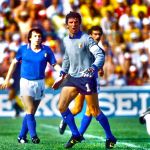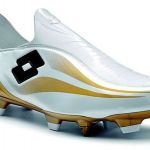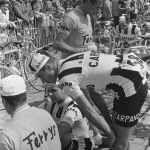
Lotto: from top to failure in 50 years of history
The Holding that controls the historic Venetian company has been declared bankrupt, and the future of the brand is uncertain
January 17th, 2019
A piece of history of sportswear could soon leave the world of sport: in recent days the court of Treviso has declared the failure of Futura 5760, the holding company that controls among others the Lotto brand. Despite the reassurances of the entrepreneur at the head of the consortium, the creditors will have time until the end of January to claim any credits. The sports brand had over 20 million debts in 2015, mainly with Veneto banks. The collapse of the former Venetian people had forced to block the budgets of the parents. Yet there were years when the brand seemed far from bankruptcy and its growth seemed unstoppable. There was a period, in the world of sport, where to contend the sponsorships of the best tennis players in the world, always icons of fashion, the greatest footballers and memorable sportsmen there were not only multinationals like Nike and adidas: the brands most worn by athletes were those of the small company founded in Montebelluna in 1973.

THE BEGINNINGS
The three Caberlotto brothers, taking the last part of their surname and overlapping two lozenges give life to the name and logo of Lotto Sport: a football field and a tennis court create the iconic four-sided figure with two sharp angles and two obtuse, indicating immediately what would have been the sports for which the company will produce the best footwear. The success of the Venetian company started from the sport that has always accompanied fashion, both on and off the field. In 1968 tennis had become Open: since then amateurs can access the most prestigious tournaments reserved for professionals and above all they can make business agreements with brands. Thus the "signature" business was born, shoes produced by famous brands that were signed by the strongest players of the time. In 1975 the Lotto brand contracted the 3 times Wimbledon champ John Newcombe and together created one of the first Lotto shoes for tennis. The "Newcombe Signature" were revolutionary shoes: they presented a leather upper without seams that improved the overall sensation of the athlete. Today no longer traded, they were very similar to the adidas signed by Stan Smith, which have marked the history of sports sneakers. They were recognizable from those of the German mark for the athlete's mustache in the blue heel patch, as well as the signature of the same on the side. They opened the history of the Lotto brand in the world of tennis and sport, which would soon be populated by shoes and garments with double lozenge.

THE GOLDEN AGE: THE 80's
After having won a Davis Cup with Tonino Zugarelli in 1976, the brand goes through three years of gold that will bring it to its peak in every sport. The most important success of the brand came in 1982: the captain Dino Zoff wore Lotto at his feet on 11 July in Madrid when he raised the World Cup.
The achievement of such an important result was not a point of arrival, but a starting point for the brand. Several other Italians in the 80s were sponsored Lotto: from athletics to fencing to footballers Salvatore Bagni, median of the national team, and the center-forward Aldo Serena.

Then there was a Moroccan athlete, who as a child wanted to be a footballer, but he poured himself on the athletic tracks because "If in one game the others are not worthy of your effort": Said Aoiuta won 44 consecutive international competitions from 800 to 10000 floors and rewrote the history of the middle distance. After the gold at the 1984 Olympic Games in Los Angeles, the Venetian brand tore the runner to Nike to accompany him in his biggest undertaking: July 22, 1987 at the Olympic Stadium in Rome, wearing a race suit and a pair of shoes branded Lotto , becomes the first man in the world to run the 5000 meters under 13 minutes bringing the Venetian company to its maximum results in athletics. From the track to the basketball court: an environment dominated by Nike today, has experienced a brief but intense presence at the top of Europe thanks to the historic victories in the 1986-87 and 1987-88 seasons of Olimpia Milano in the Champions Cup. In the first of the two years, the Tracer team made the Grand Slam: in addition to being European champion, he also won the Scudetto and the Italian Cup at the helm of Dan Peterson. The formation of the phenomena Mike D'Antoni, Bob McAdoo and Dino Meneghin repeated the European success the following year triumphing against the Maccabi Tel Aviv, beaten in the final for the second time in a row. The main sponsor on the shirts had become Philips, but the logo on the top right was Lotto, which accompanied the Milanese team to the biggest companies in its history.

REMAIN TO THE TOP
Repeating after a decade of countless successes is difficult, according to a large but very young brand compared to the competition. Yet, in sharp contrast with today's risk of failure, the company manages to remain at the top of the sport in the 90s. The new decade, however, starts with a drawback: before the sponsorship from 2005 to 2012 with Fiorentina (the longest for the brand in the world) already in 1992 the purple shirts presented the double lozenge on the chest. Nothing strange for a brand that at the time was loved by sports obstacles, were it not for the geometric lines on the jersey that reminded of swastikas. The Venetian company is built to pick up the product, which has however gone down in history as a famous design error. Lotto, by Boris Becker. The trophies have recently been auctioned, along with shoes and branded outfits. In addition to the iconic German tennis player, in those years in the best tournaments in the world wore the Lotto, among others: the Austrian champion Thomas Muster and the holder of all the records in women's tennis Martina Navratilova. From white it was moving to color, but the Italian company remained at the top holding its head on the rise of Nike. They were white with red numbers the Lotto sweaters that were worn by the European Champions in 1994: on 18 May at the Olympic Stadium in Athens the Champions League final was played between Milan and Barcelona.
Upon returning to the second half a throw on the right wing of Albertini is intercepted by blaugrana Nadal who, albeit in clear advantage, waited too long to raise the ball. Savicevic steals the ball so and without even actually stop it, after the rebound on the pitch starts a lob from the short limit of the area that ends its trajectory behind Zubizzarreta. The "Genius" marks one of the most beautiful goal in the Milan history: the brand was imposed in club teams already in the first year of technical sponsorship with the Rossoneri, which would last until 1998. In those years, in which he also sponsored the 'Holland and the champion Ruud Gullit, who wore the Lotto "Stadio" with the iconic tongue that bent forward covering the knot of laces. Accompanying Croatia during his first world experience in 1998, when debutant at the World Cup in France and dragged by the goals of Davor Suker (who was the tournament's top scorer) came third with the Lotto brand on the jerseys.

THE NEW MILLENNIUM AND THE DESIRE TO DO NOT STOP
After closing the Nineties with Guidolin's Vicenza accompanied in the Coppa delle Coppe semifinals in the 1997-1998 season (then lost against Chelsea), the brand celebrates its 30th anniversary by overcoming its umpteenth maturity: Juventus wears Lotto in the Serie A win in 2002, 2003 and in the Manchester final lost against Milan.

If in the 2014 world the brand "contributed" to the elimination of the Azzurri (Costa Rica won 1 to 0 in the group stage dressed Lotto), on the podium of Berlin 2006 Lotto saliva with the greatest innovation in its history and, to date, one of the greatest innovations in the world of football, launching a trend followed by all sports brands: shoes without laces. Lotto succeeded, in an age when the materials did not allow it because it was still not very elastic, to minimize friction between the foot and the ball by inserting an elastic plastic bridge that made contact with the sphere more direct. The "Zerho Evolution" Lotto was launched in Germany at the feet of Luca Toni, Simone Perrotta and Mauro Camoranesi, from which the "Zerho Gravity" was born. The model was the first shoe in the world without laces and arrived on the market several years before the competitors (the first adidas model without laces, the "Ace PureControl", were launched in 2016). The innovation and comfort of that model, unsurpassed for several years, are in sharp contrast with the current situation of the brand that is in danger of disappearing. But there are still those who, like the Atalanta defender Andrea Masiello, has never stopped loving him. Recently he reported on the playgrounds that pair of shoes, wearing it from the 2016-2017 season in two different colors: blue and black combined with the home kit and white with dark blue logo with the away kit.

FROM 2010 TO TODAY
With the same rapidity with which the brand had established itself in the sporting world in the eighties, today it is slowly reshaping. The exploit of Piatek in this first part of the championship with the Genoa shirt (the only team in Serie A sponsored by the brand today) only brings to mind but does not equal the more than 300 goals that Luca Toni scored wearing the best Lotto models. Memories are even more bitter in tennis, almost the only sport left in the brand's offer. The feat of Marco Cecchinato at the Roland Garros 2018, arrived in the semifinals after triumphing against Djokovic (wearing the "Stratosphere III", the flagship shoes of the Lotto brand in tennis) still fails to match the deeds of the 80's champions. 2010 Francesca Schiavone accomplished the task of bringing a Grand Slam in the history of the brand by winning the Roland Garros, but it is Marion Bartoli and Gianluigi Quinzi to show the reality of the manufacturer: from rising stars (the French won Wimbledon in 2013 and Italian triumphed a year earlier in the men's youth tournament) of tennis have now disappeared from the stages that count, as do the Lotto products.


















